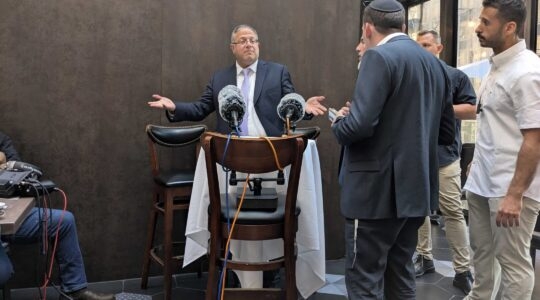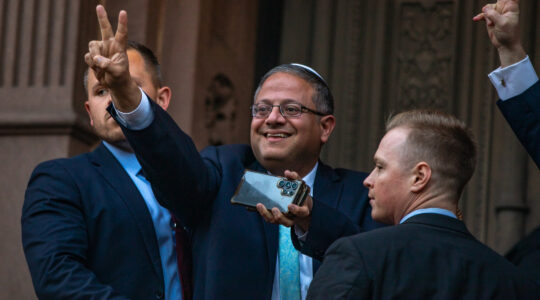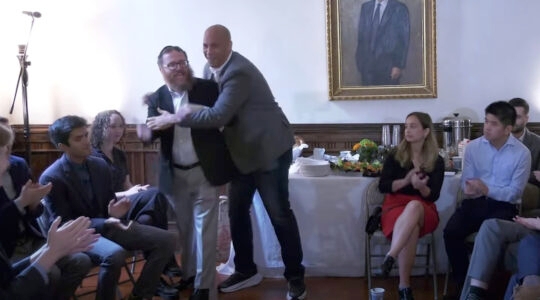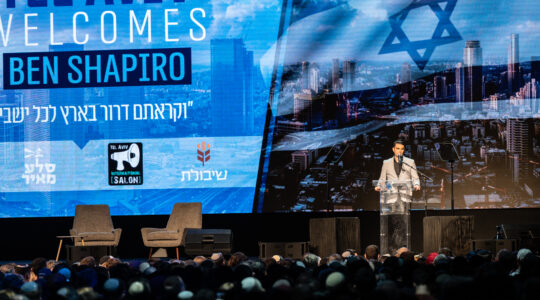(JTA) – The families surround long tables covered by white tablecloths. Festive decorations line the walls, and the kitchen is free of chametz, the leavened foods forbidden on Passover. Seder plates sit in front of hungry participants.
But instead of someone reading the Haggadah or reciting the kiddush over wine, the crowd sings a modern Israeli kids’ song about Passover: “Great joy! Great joy! Spring has arrived, Pesach is here!”
So begins the holiday at Ramat Yochanan, an 80-year-old secular kibbutz near Haifa.
Many secular Israelis attend traditional seders on Passover; as with American Jews, the seder is one of Israel’s most widely performed religious rituals. Several of Israel’s oldest kibbutzim depart from tradition, however, and conduct secular seders according to their own sensibilities rather than the dictates of the traditional Haggadah.
At many secular kibbutzim, the emphasis is on the themes that motivated their founders to settle the land nearly a century ago: freedom, nature and the Jews’ return to the land of Israel.
Ramat Yochanan’s seder does not “tell midrashim, how many plagues happened at the sea, this and that,” said Miri Feinstein, who organizes the meal. “Our conversation about leaving Egypt and guarding the freedom of the other is more important.”
Its Haggadah features illustrations of landscapes and Jewish history drawn by a kibbutz member from the 1940s and includes biblical verses not found in the traditional text — from the book of Exodus as well as from "Song of Songs," which traditionally is read on Passover.
At Kibbutz Ein Shemer, near the Mediterranean coast, the seder is marked by children’s plays, Israeli folk sing-alongs and musical performances. Hundreds of kibbutz members and their guests attend. The kibbutz Haggadah, which it has used for decades, has four sections: spring, from freedom to slavery, peace and the land of Israel. The division is a nod to the sets of four (cups of wine, sons, etc.) that pepper the original Haggadah.
“We see it as the founding holiday of our nation, which we celebrate according to our rules,” said Anna Sasson, who has been running the Ein Shemer seder for 15 years. “We give it its own character from our secular world, and we have a lot of love for tradition, homeland, agriculture, spring and freedom.”
As at other kibbutzim, Ein Shemer pays homage to the seder’s religious roots in its Haggadah by quoting heavily from the Bible, using verses describing springtime or the Exodus.
Shlomo Deshen, author of “Secular Israelis on Pesach Night,” says kibbutzim long have led the way in making Passover a modern Israeli holiday of “Zionism, socialism, humanism.”
“The holiday inspired creative ceremonies whose greatest expression was through the new Haggadahs of the kibbutz movement,” Deshen wrote.
Today, even many religious Israelis have incorporated nontraditional elements such as children’s plays and modern songs into their own seders. But the kibbutzim take things further.
At Ramat Yochanan, one of the community’s Passover highlights is a gathering on the holiday’s first day in a wheat field for a reenactment of a ceremony described in the Talmud: the wheat harvest celebration.
“Is the sun coming?” asks a man standing on a stage. “Is it time for the harvest?”
“Yes!” the members answer. The kibbutz’s boys then rush into the field to grab sheaves of wheat and throw them into baskets held by the community’s girls. The girls swing the baskets up and down and side to side while a leader reads passages from the Bible about the wheat harvest and settling the land. A choir and band then perform on stage while kibbutz members sing and dance to Israeli folk songs.
Kibbutz Mishmar Haemek, in northern Israel, stages a smaller harvest ceremony.
“Our holiday is based on our being an agricultural town and the spring being an awakening,” said Raya Shlomi, who runs the kibbutz’s seder. “We also have the story of the Exodus from Egypt, but unlike a traditional seder, where God performs all the miracles, Moses plays the central part.”
As the kibbutz movement has changed in recent decades, becoming less communal, the seders at Ramat Yochanan have shrunk. Decades ago, more than 1,000 people used to turn out for the holiday celebration; today the number is down to 400, according to Feinstein. Most kibbutz members now choose to celebrate at home with their families, she says.
“People need to feel like the seder is theirs and that they’re not sacrificing themselves,” she said. “The collective used to be in the center. Now the individual is in the center, and he needs to decide what’s appropriate for him.”
Feinstein isn’t ready to give up on the communal meal.
“What I see in the kibbutz seder is ‘brothers sitting together,’ ” she said, quoting a famous biblical verse. “Even when we were poor, we always invested in Passover. People want to safeguard the community.”
JTA has documented Jewish history in real-time for over a century. Keep our journalism strong by joining us in supporting independent, award-winning reporting.





